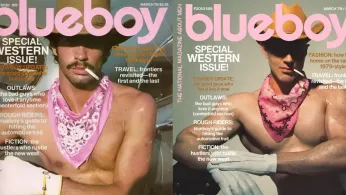
Aug 19
Reviving Queer Icons: ‘The Queer Magazine Series’ Pays Tribute to Queer Print Media
READ TIME: 3 MIN.
IIn a digital age marked by rapid scrolling and ephemeral content, the significance of print media—especially within LGBTQ+ communities—can be easily overlooked. The Queer Magazine Series, a collaborative project by photographer Austin Ruffer and Brazilian singer Yann seeks to counter that trend by reviving and reimagining iconic covers from queer magazines that once served as lifelines for visibility and self-expression. The project debuted in August 2025 and has quickly generated discussion across LGBTQ+ media platforms, including Gayety.
Ruffer and Yann’s series revisits covers from cult favorites such as XY, BUTT, Drummer, Honcho, Playguy, and Blueboy—magazines that provided sanctuary, celebration, and community before mainstream media acknowledged queer identities. Each image is styled meticulously to capture the spirit and aesthetic of the original publications, balancing nostalgia with contemporary relevance. The restaged covers highlight how these magazines were more than glossy pages; they were crucial platforms for liberation, joy, and authentic self-representation at times when such spaces were rare.
Yann, speaking with Gayety, emphasized the importance of these cultural artifacts: “Each publication had its own unique voice, whether it was celebrating queer joy, pushing the boundaries of art and sexuality, or creating a safe space for expression at times when mainstream culture gave us nothing. By reimagining them, I’m hoping we both honor their legacy and spark new conversations about how vital queer media has always been, and continues to be”.
Historically, magazines like XY and BUTT acted as hubs for connection, activism, and creative exploration, giving LGBTQ+ individuals a sense of belonging and visibility. These publications offered opportunities for writers, artists, photographers, and everyday readers to share stories that might otherwise be marginalized or erased. According to LGBTQ+ media historians, the role of such magazines in fostering resilience and pride—especially during eras of heightened stigma and exclusion—cannot be overstated.
The series not only pays homage to this legacy but also prompts viewers to consider the future of queer representation in media. As digital platforms continue to proliferate, projects like Ruffer and Yann’s remind us that physical archives and print history are essential components of LGBTQ+ culture.
The Queer Magazine Series is especially timely in 2025, as discussions around queer visibility, censorship, and representation remain urgent. The project’s restaging of magazine covers invites viewers to reflect on how much has changed—and how much still needs to change—in the fight for inclusive, authentic storytelling. In his interview with Gayety, Yann noted, “They were lifelines, sources of visibility, and platforms for liberation. By reimagining them, I’m hoping we both honor their legacy and spark new conversations about how vital queer media has always been, and continues to be”.
Primary coverage of the series on Gayety includes in-depth interviews and photo galleries that showcase the artistry and intention behind each restaged cover. Social media engagement on platforms like Instagram also demonstrates the project’s resonance across generations, with users commenting on the importance of remembering and celebrating queer media history.
The response from LGBTQ+ artists, activists, and readers has been overwhelmingly positive. Many see the project as a vital reminder of the role community-driven media plays in fostering pride, resistance, and solidarity. By highlighting magazines that gave space to diverse voices—gay, lesbian, bisexual, transgender, non-binary, and beyond—Ruffer and Yann’s work affirms the need for platforms that reflect the full spectrum of queer experience.
In a broader sense, the series encourages younger LGBTQ+ audiences—many of whom may not have encountered print magazines firsthand—to engage with their own history, recognize the power of media representation, and participate in ongoing conversations about inclusion and visibility. As discussions about censorship and erasure persist globally, the project stands as a testament to the resilience of queer storytelling and the enduring impact of physical media.
The Queer Magazine Series merges visual artistry with historical reflection, honoring the legacy of LGBTQ+ print media while sparking dialogue about the future of queer representation. By resurrecting iconic covers and celebrating their significance, Austin Ruffer and Yann invite audiences to appreciate the cultural landmarks that helped shape queer identity—and to imagine new forms of media that will continue this essential work for generations to come.






